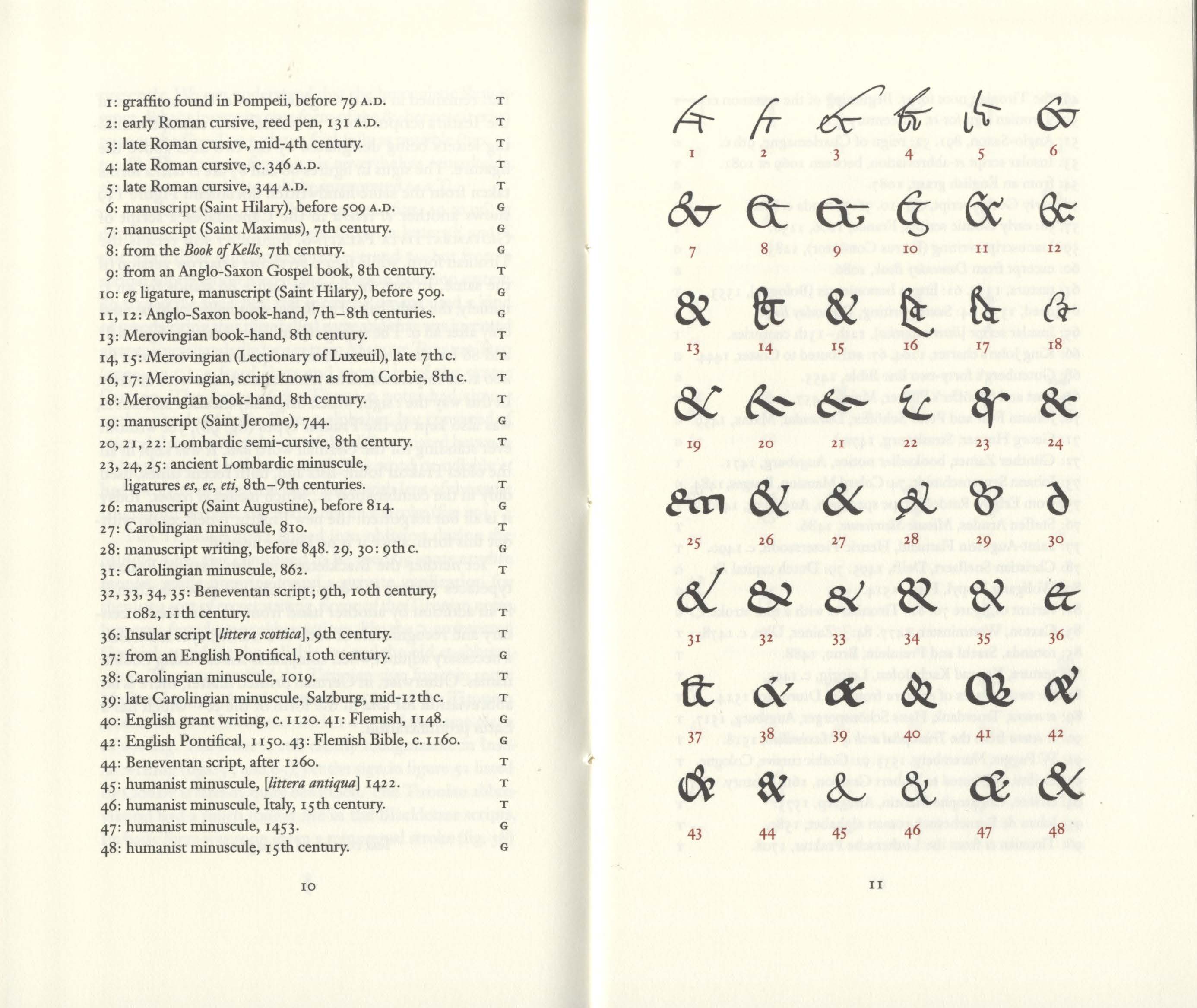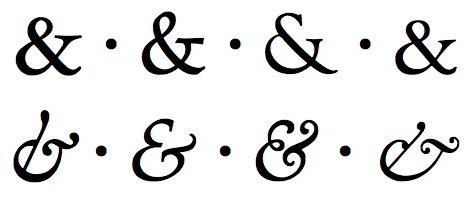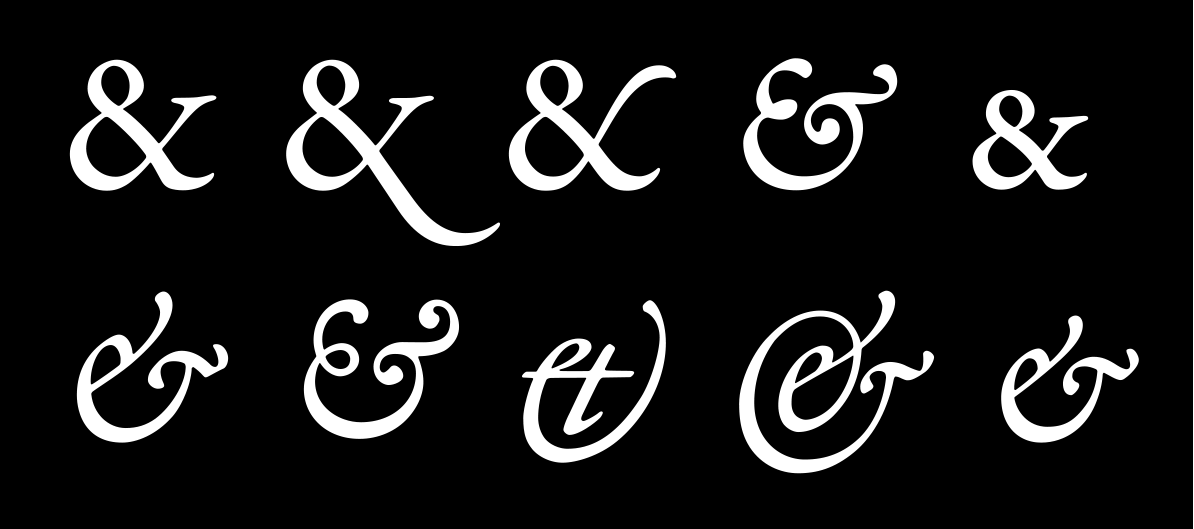........................................
:: Syllabus :: Modular Grid :: Modular Font :: Publication :: Finishing Up :: Ampersand :: class google drive
.................................................................
Professor: Andrea Herstowski
Office: 353 Chalmers Hall
Office
hours: by appointment
email: herstow@ku.edu
................................................................
jump to date
- Wednesday, Dec 1
- Monday, Dec 6
- Wednesday Dec 8
- Dec 10: Stop Day
- Wed, December 15 Final
..........
- - - - - - - - - - - - - - - - - - - - - - - - - - - - - - - - - - - - - - - - - - - - - - - - - - - - - - - - - - - - - - - - - - - - - - - - - - - - - - - - - -
The Ampersand
The origin of the ampersand can be traced back to the Latin word “et,” meaning “and.” The E and the T that make up this word were occasionally written together to form a ligature (a character consisting of two or more joined letters). Writing the word this way saved the writer time, with one letter flowing seamlessly into the next – a form of cursive or joined up writing.
We know the origina of the symbol Et but where did the word Ampersand come from.
Traditionally, when reciting the alphabet in English-speaking schools, any letter that could also be used as a word in itself (“A”, “I”, and, at one point, “O”) was repeated with the Latin expression per se (“by itself”). It was common practice to add the “&” sign at the end of the alphabet as if it were the 27th letter, pronounced as the Latin et or later in English as and. As a result, the recitation of the alphabet would end in “X, Y, Z, and per se and”. This last phrase was routinely slurred to “ampersand”. The term "ampersand" had entered common English usage by 1837. explained
_ _ _ _ _ _ _ _ _ _ _ _ _ _ _ _ _ _ _ _ _ _ _ _ _ _ _ _ _ _ _ _ _ _ _ _ _ _ _ _ _ _ _ _ _ _ _ _ _ _ _ _ _ _ _ _ _ _ _ _ _ _ _

The invention of the ampersand is usually credited to Marcus Tullius Tiro, who was the faithful slave and secretary to the Roman lawyer and politician Cicero. Tiro invented a shorthand writing system in 63 B.C. called Tironian Notes, which included the ampersand. https://creativepro.com/ampersand-history-usage/
_ _ _ _ _ _ _ _ _ _ _ _ _ _ _ _ _ _ _ _ _ _ _ _ _ _ _ _ _ _ _ _ _ _ _ _ _ _ _ _ _ _ _ _ _ _ _ _ _ _ _ _ _ _ _ _ _ _ _ _ _ _ _
Jan Tschichold, 1902 – 1974. Tschichold devoted an entire study to the development of the ampersand in his 1953 booklet “The Ampersand: Its Origin and Development,” where he collected hundreds of examples of the symbol throughout history, recording its development from the piece of ancient graffiti to the familiar ‘&’ used today. Within this collection are examples from the eighth century which are already recognizable as the modern ampersand. (we have an original copy at KU and zeug made a beatiful reproduction + a contemporary take)
Tschichold’s masterful contribution to the study of the ampersand came in 1953 in the form of a short booklet. Tschichold collected hundreds of ampersands to chronicle the character’s evolution from 1st century Pompeiian graffiti, through medieval manuscripts, and finally to 19th century printed forms. Even a single page of Tschichold’s menagerie of ‘and’-signs contains an embarrassment of typographical riches.



Full pdf from the Watson Library
_ _ _ _ _ _ _ _ _ _ _ _ _ _ _ _ _ _ _ _ _ _ _ _ _ _ _ _ _ _ _ _ _ _ _ _ _ _ _ _ _ _ _ _ _ _ _ _ _ _ _ _ _ _ _ _ _ _ _ _ _ _ _

Roman (top row) and italic (bottom row) ampersands. From left to right: Hoefler Text (Hoefler & Frere-Jones), Palatino (Linotype), Goudy Old Style (urw) and Garamond (Monotype). please see shadycharacters.co.uk/2011/06/the-ampersand-part-2-of-2/
Jonathan Hoefler tried to sum up his love for the ampersand, which he says he’s been known to draw “to excess.” “It’s always an opportunity for adventure,” he says. “Even the most conservative typefaces can give sanctuary to a whimsical ampersand or two.”www.fastcompany.com/3055622/why-designers-love-the-ampersand
_ _ _ _ _ _ _ _ _ _ _ _ _ _ _ _ _ _ _ _ _ _ _ _ _ _ _ _ _ _ _ _ _ _ _ _ _ _ _ _ _ _ _ _ _ _ _ _ _ _ _ _ _ _ _ _ _ _ _ _ _ _ _
There are two basic forms of the ampersand, with many variations of both: the traditional, classic double counter version (&), and the style that looks more like an E or an et, sometimes with the addition of curves and flourishes. It is common for an upright, Roman typeface version to have the first style, with its companion italics switching to the second, more calligraphic version. Most fonts have just one ampersand, but with the expanded character set of the OpenType font format, some contain two or more versions, occasionally including a small cap ampersand that is designed to match their shorter height.

Adobe Garamond Premier Pro has five different ampersand glyphs for both the Roman (upper) and the Italic version (lower). https://creativepro.com/ampersand-history-usage/
Jeremiah Shoaf, Typewolf,...ampersands are usually only used for display type–the large or eye-catching type used in headlines, signage, and advertisements–so the character can be more ornate, even in fonts that are primarily designed for text. A good example of this effect in action are the ampersands of Kings Caslon, Bookmania, Didot Italic, and Cochin Italic, all of which really cut loose and be more flamboyant than their associated typefaces. www.fastcompany.com/3055622/why-designers-love-the-ampersand
_ _ _ _ _ _ _ _ _ _ _ _ _ _ _ _ _ _ _ _ _ _ _ _ _ _ _ _ _ _ _ _ _ _ _ _ _ _ _ _ _ _ _ _ _ _ _ _ _ _ _ _ _ _ _ _ _ _ _ _ _ _ _
RESOURCES (read them if you want)
Print History: https://printinghistory.org/ands-ampersands/
History and Usage of the Ampersand: creativepro.com
Design History: Get to know your ampersands: 99designs.com
Ampersand for Branding: moshik.net
Why Designers love the Ampersand: fastcompany.com
Jan Tschichold: The Ampersand: Its Origin and Development.pdf
Today: Contemporary
::